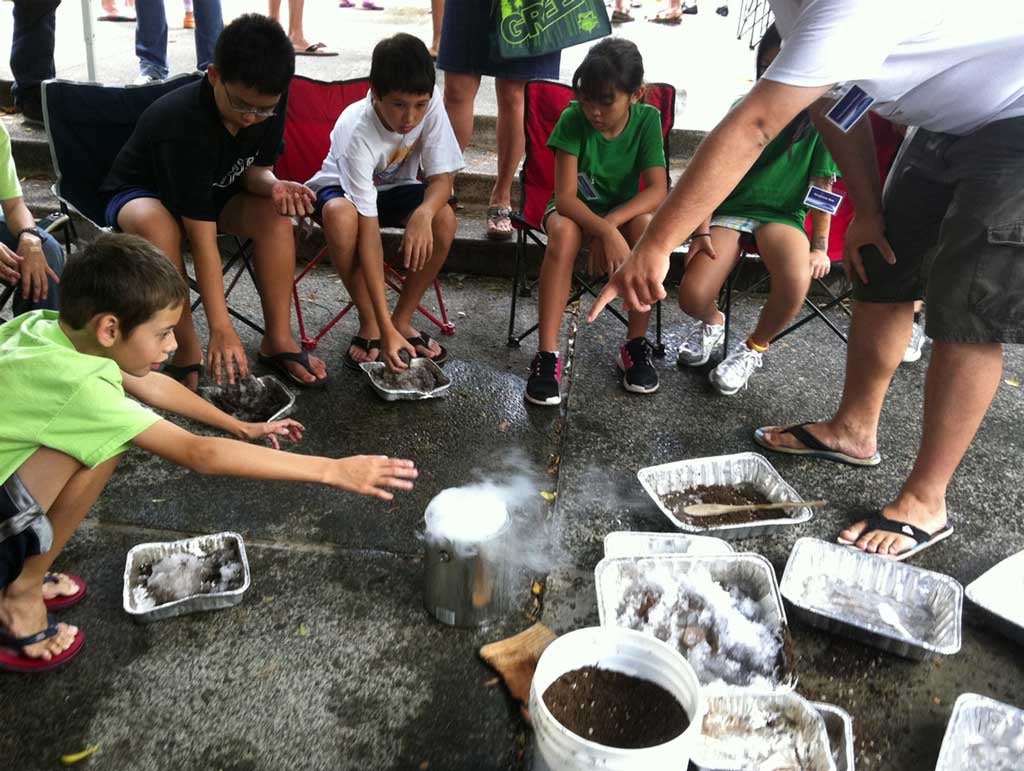In my February story, “What Halley’s Comet taught us,” I mentioned that astronomers characterized the makeup of the famous celestial visitor as a “dirty snowball.” Once Halley made its most recent close approach, in 1986, the suite of probes that studied it in detail confirmed this view — mostly. It turns out that the comet’s nucleus is actually less volatile than scientists had suspected, meaning it was made up of more inert material than they thought, making it more of a “snowy dirtball.”
Whatever you want to call it, though, the fact remains that Halley, like most comets, is a mixture of ice, dirt, and other trace materials. Because these are ingredients we have here on Earth, it’s become a popular educational tool to concoct comets in the classroom, astronomy club outreach tent, or your own backyard. I’ve included two different “recipes” below, both adapted from NASA documents, to help you cook up your own comet. The first is a more serious, realistic recipe, and the second is more playful and whimsical (and edible). Feel free to try out either one next time you need a way to bring the heavens down to Earth.
1. “Serious” comet recipe
This recipe is for a 6-inch (15 centimeters) version of Comet Halley itself, as opposed to a generic comet (at a scale of 1:1,000,000,000,000). Some of the materials are dangerous for children to handle, so an adult should definitely be in charge here, with possible student helpers. It’s a good idea to practice the recipe once by yourself before trying it in front of others.
Ingredients:
- 2 cups water
- 2 cups dry ice (frozen carbon dioxide, available from ice companies in most cities)
- 2 tablespoons sand or dirt
- A dash of ammonia
- A dash of organic material (dark corn syrup works well)
Other materials you should have on hand:
- An ice chest
- A large mixing bowl (plastic if possible)
- 4 medium-sized plastic garbage bags
- Work gloves
- A hammer, meat pounder, or rubber mallet
- A large mixing spoon
- Paper towels
Directions:
- Cut open one garbage bag and line your mixing bowl with it. Nest remaining bags inside one another.
- In the mixing bowl, mix the water, sand, and dirt, stirring well.
- Add the dashes of ammonia and organic material (corn syrup), and stir until well mixed.
- Place the dry ice in the nested garbage bags (be sure to protect your skin with the gloves while handling dry ice).
- Crush the dry ice with the hammer, then add the dry ice to the water mixture while stirring vigorously until it’s almost completely frozen.
- Once it’s nearly solid, lift the frozen mixture/comet out of the bowl, using the plastic liner, and shape it as you would a snowball.
- Once it’s frozen enough to hold its shape, unwrap your comet.
Feel free to display it in a sunny spot, as the heat will cause its ingredients to melt and sublimate (transform directly from a solid to a gas). In its final form, the comet is reasonably safe to touch, but everyone should still be careful not to get burned by the dry ice.
2. “Playful” and edible comet recipe
This recipe features a more hands-on approach for any participants, and while it’s not as realistic as the first, it will probably be a more memorable experience. It also works as a general simulation of comets because it maintains their makeup as a cold mixture of ices and rocky materials. A popular approach is to make several comets as once, each with a different makeup and materials, after dividing into smaller groups or teams.
Ingredients (per team):
- 1/2 gallon of ice per team
- Crushed cookies (to represent dust)
- Peanuts (to represent rocks)
- Coconut flakes (to represent carbon dioxide)
- Other small candies that won’t dissolve in ice cream (such as toffee, peppermint, and gummy bears)
- 2/3 cup whole milk (skim, 1%, and 2% won’t work)
- 5 tablespoons sugar
- Dash of vanilla extract
- 1/3 cup evaporated milk (or cream)
- 10 tablespoons salt
Other materials each team should have on hand:
- One gallon-size re-closable plastic bag
- One gallon-size re-closable plastic bag
- One small cup and plastic spoon per person
- One pair of oven mitts (or work gloves)
Directions:
- In the sandwich-size bag, mix the evaporated milk (or cream), whole milk, sugar, and vanilla extract.
- Sprinkle in the other solid ingredients (cookies, peanuts, etc.) and mix well. (Each team should choose a different set of solid ingredients.)
- Squeeze any extra air out of the sandwich bag and seal it tightly (try turning it upside down to make sure it doesn’t leak).
- Put the mixed bag at the bottom of the gallon bag, along with all the salt. Fill it just over 1/3 full of ice.
- Close and seal the gallon bag tightly (check for leaks).
- Gently shake and roll the gallon bag, keeping it in constant motion for 6 to 10 minutes or until half the ice has melted. (Have the oven mitts or work gloves ready, as the bag will soon become extremely cold.)
- Keeping the gallon bag closed, seek out and examine the smaller sandwich bag by feel; when it has hardened into soft ice cream, remove the sandwich bag from the gallon bag.
- Briefly rinse the outside of the sandwich bag to remove any salt and ice.
- Open the sandwich bag and serve the ice cream inside the cups.
In addition to simply enjoying the frozen “comet,” different teams can exchange samples so participants can “research” an unknown comet, and try to determine the foreign ingredients.











